Design 2014
Photos of Students Work and Designs
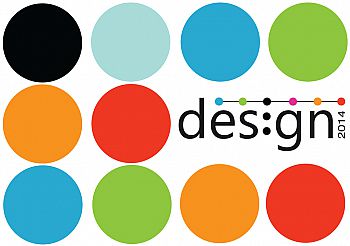
Great design with clear intent can bring positive benefits to us, not only as individual consumers but also as a society, where it can shape community-wide advancements and developments.
This years Product Design Degree graduates produced a diverse range of work and this arena showcases those students whom were the selected winners of the Product Design Awards 2014.
Design 2014 Brochure [PDF 8.94MB]
- Eco Design Award - sponsored by Claire Potter Design
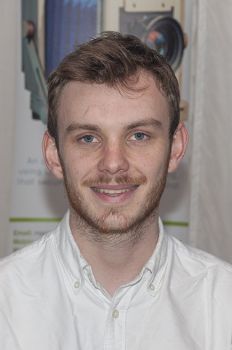
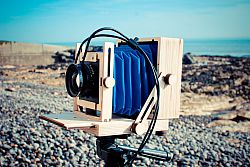 Award Winner: Max Grew
Award Winner: Max GrewProduct: The Intrepid Large Format
The Intrepid Large Format camera is a redesign of the traditional large format camera; these cameras are the kind that uses bellows and sheets of film, with the photographer often placing a black cloth over his head to focus the image on a glass screen. The large format camera has its origins at the very beginning of photography; pictures were made onto glass plates covered in dangerous chemicals that required the sitter to stay still for minutes at a time. In the 1930s-50s they became the go to camera for press photographers and artists, with American photographer Ansell Adams becoming a pioneer in landscape photography.
Since then this branch of photography has continued defiantly to produce some of the most important and beautiful pictures ever created. It has resisted the digital revolution and continues to attract new passionate photographers despite the technology being over 100 years old. This attraction is for one simple reason, large format photography is as far away from digital photography you could possibly get, there is 0% automation, your camera does not have a microchip for a brain it has a photographer, it is entirely pure photography and allows maximum creative freedom. The large format camera is a tool for art, not convenience, the images have warmth to them akin to the sound of a vinyl record and a quality to them you just can’t quite put your finger on. So maybe it isn’t one simple reason, maybe I don’t really know exactly why these cameras are so special. I do however know they are manifestly important to the future of photography, and to me.
So why redesign this ‘perfect’ camera? Well there are two problems. Firstly this type of camera is very expensive often costing in the range of £800 to £1500, this becomes a limiting factor for new young photographers wishing to get started with this type of photography. Secondly these cameras tend to be mostly hand made, this is a real skill and one that could be lost if the cameras are not purchased by the next generation of photographers. It’s a downward spiral of high costs and loss of manufacturing knowledge that could eventually lead to these cameras no longer being produced. This is what led me to design an open source and affordable large format camera, The Intrepid.
- Eco Design Award Highly Commended - sponsored by Claire Potter Design
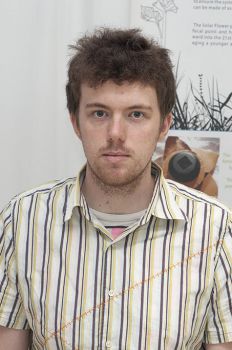
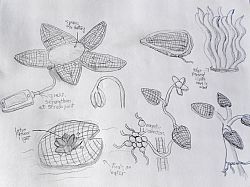 Award Winner: Simon Lamb
Award Winner: Simon LambProduct: Solar Flower - campsite charging station
The Solar Flower is a photovoltaic charger for use with multiple USB devices including smartphones, tablet computers, cameras and e- readers. The charger is designed with cues from the woodland environment, commonly used for camping spots, this provides a highly aesthetic and elegant folding solution for storage and utilises recycled and reclaimed materials with life-cycle analysis to ensure the system and its component parts can be made of as many eco-friendly parts as possible. The Solar Flower provides a secondary social focal point and helps project camping forward into the 21st century as well as encouraging a younger audience into the activity.
- Eco Design Award Highly Commended - sponsored by Claire Potter Design
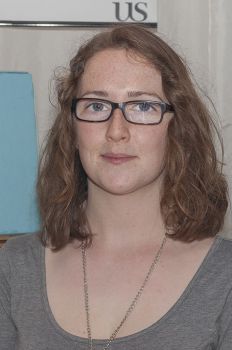
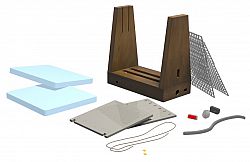 Award Winner: Rebecca Cunningham
Award Winner: Rebecca CunninghamProduct: Modular, Repairable Appliances
Electrical appliances are one of the greatest contributors to landfill in the UK; because of the way they are designed today, it is virtually impossible to separate them into their individual components for recycling or reuse. This also makes them more difficult to repair, so if just one component stops working, the whole product must be replaced.
My aim for this project was to change the way that we look at these ‘disposable’ products and to create a new range of appliances which will not become the next generation of post-consumer waste. The basis of the designs will be modularity, with each product being made up of easily interchangeable components and constructed in a way which allows for straight-forward disassembly. This new accessible design will enable the user to repair the appliance and replace damaged components, rather than replacing the entire product.
With the world moving towards a more circular economy, the products we design today must still have value tomorrow. The materials which make up the range of appliances are selected for their ability to be re-processed and re-circulated, with minimal waste along the way.
- An Aid to Living Award - sponsored by Saville Jones Architects
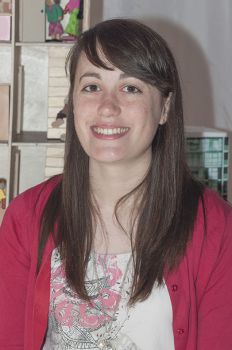
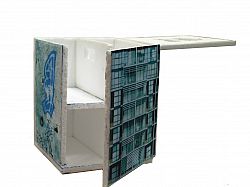 Award Winner: Abigail Bainbridge
Award Winner: Abigail BainbridgeProduct: The Flat Pack
‘Designing a tool that increases the access a child has to their inner emotions’
So often we can overlook the importance of building children up and taking the time to listen to them. With the knowledge that society benefits between £7.60 and £9.20 for every £1 invested annually into services that are designed to catch children’s problems early and prevent them from re-occurring; play therapists understand that it is not only important for the child, but also the community.
Play therapists use many successful tools with children, one of the most used is a doll’s house; this allows the child to project their emotions onto different characters and gives the therapist an insight into what might be happening in their life.
However, although this is one of the most common tools it has several flaws which are being addressed in my final year project. Doll’s houses are usually girly and perfect, filled with old fashioned furniture, are not culturally diverse and not always mobile. One main problem is that 2/3 of all referrals are boys, so playing with a girly doll’s house isn’t going to be their first choice. Studies also show that a high percentage of children who are referred to play therapists are from poorer families.
Considering all of this, I created a doll’s house that is in the form of a collapsible block of flats, with up to date furniture, and a diverse collection of dolls to better represent today’s society so that the child can be more easily engaged. On top of this, provoking items such as alcohol have been introduced and changeable magnetic faces for the dolls, showing different feelings to help the child express emotions they might not know how to articulate. The block of flats can be collapsed and put in a bag to be transported with ease.
- Most Professional Product - sponsored by Design Brighton
-
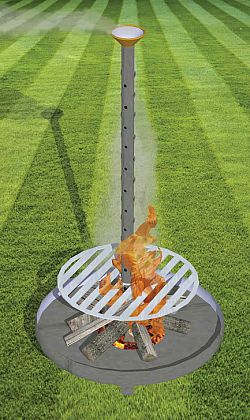 Award Winner: Edward Simmons
Award Winner: Edward SimmonsProduct: The Salamander, Campfire Smoke Extractor
One of the principle charms of camping is relaxing around a roaring campfire. However the sad reality can be smoke billowing into your eyes, which can be both painful and temporarily blinding. Furthermore smoke from campfires is twelve times more carcinogenic than tobacco smoke, and can also exacerbate asthma and other lung complaints.
The principle aim of this product, The Salamander, is to enable campers to enjoy sitting around a campfire whilst the smoke is channelled away. This unique product is an internal chimney that has the fire built around it. This allows the user to bask in the warmth and ambiance of the fire, whilst the specialised dimpled design safely removes the smoke and ash. There is ample capacity to cook on the open fire with the removable grilling racks. Furthermore the campfire is raised from the ground, thereby reducing the risk of wildfires.
The Salamander is designed to be available in two versions, permanent and removable. Permanent will be concreted in, allowing campsite owners to dictate where the campers may safely build fires. The domestic version is for family campers and can be used anywhere. The Salamander will enable all users to have a safer and more enjoyable camping experience around the perfect campfire.
- Most Professional Product - Highly Commended - sponsored by Design Brighton
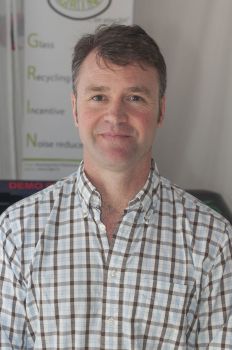
Two Winners were commended in this category.
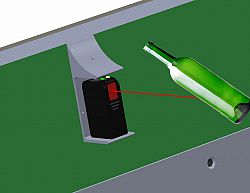 Award Winner: Stewart Gordon (top photograph)
Award Winner: Stewart Gordon (top photograph)Product: Put a GRIN on Your Bin
GRIN is a product designed to increase the amount of glass that we recycle. It does this by solving two issues associated with glass recycling - the noise generated by collecting the glass and the lack of an incentive for people to recycle. Both of these have been identified as issues by Brighton & Hove City Council GRIN is a Glass Recycling Incentive, low Noise product that can be inserted into a range of existing communal recycling bins.
Primarily, GRIN eliminates much of the noise caused by glass bottles colliding on collection. This allows larger communal recycling bins to be located in residential areas which, in turn, leads to higher rates of recycling. This is achieved by decelerating the bottles fall through a layer of brushes.
Secondly, GRIN provides a mechanism to capture data on the amount of glass recycled by a single household, an individual bin or a community. This data allows councils to establish a reward scheme to encourage higher recycling rates. Data is captured by a clear object detection sensor, connected to an entry identification system. The whole system is solar powered.
Benefits of GRIN include:
- Higher rates of recycling
- Landfill reduction
- Council savings
- Community incentive
- Less noise
- Solar powered


Award Winner: Max Grew (bottom photograph)
Product: The Intrepid Large Format
The Intrepid Large Format camera is a redesign of the traditional large format camera; these cameras are the kind that uses bellows and sheets of film, with the photographer often placing a black cloth over his head to focus the image on a glass screen. The large format camera has its origins at the very beginning of photography; pictures were made onto glass plates covered in dangerous chemicals that required the sitter to stay still for minutes at a time. In the 1930s-50s they became the go to camera for press photographers and artists, with American photographer Ansell Adams becoming a pioneer in landscape photography.
Since then this branch of photography has continued defiantly to produce some of the most important and beautiful pictures ever created. It has resisted the digital revolution and continues to attract new passionate photographers despite the technology being over 100 years old. This attraction is for one simple reason, large format photography is as far away from digital photography you could possibly get, there is 0% automation, your camera does not have a microchip for a brain it has a photographer, it is entirely pure photography and allows maximum creative freedom. The large format camera is a tool for art, not convenience, the images have warmth to them akin to the sound of a vinyl record and a quality to them you just can’t quite put your finger on. So maybe it isn’t one simple reason, maybe I don’t really know exactly why these cameras are so special. I do however know they are manifestly important to the future of photography, and to me.
So why redesign this ‘perfect’ camera? Well there are two problems. Firstly this type of camera is very expensive often costing in the range of £800 to £1500, this becomes a limiting factor for new young photographers wishing to get started with this type of photography. Secondly these cameras tend to be mostly hand made, this is a real skill and one that could be lost if the cameras are not purchased by the next generation of photographers. It’s a downward spiral of high costs and loss of manufacturing knowledge that could eventually lead to these cameras no longer being produced. This is what led me to design an open source and affordable large format camera, The Intrepid.
- Best Branding and Graphics - sponsored by Viva Magazine
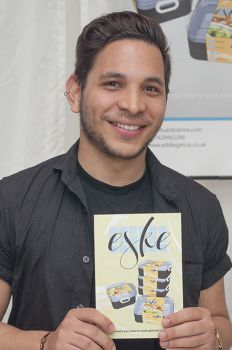
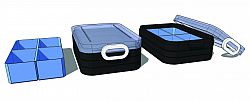 Award Winner: Eddie Garcia
Award Winner: Eddie GarciaProduct: Eske
With a focus on health conscious individuals who follow an exercise and nutrition monitored routine, Eske is an alternative to ready meals that gives the user the opportunity to cook a balanced meal from fresh raw ingredients.
The product has been designed with dual purpose: to serve as a lunchbox after the offered ingredients have been cooked, and as a measuring tool for each ingredient in the recipe so the user can recreate the meal in the future.
Giving the consumers the opportunity to actually cook the meal, not just reheat it, allows them to know exactly what goes into the dish, a great prospect within the target demographic, who rarely get to eat ready meals off the shelves. Furthermore, the inner container provided offers compartments of the right size for each ingredient along with the appropriate visual aids to help the user remake the recipe whenever needed.
- Best Branding and Graphics - Highly Commended - sponsored by Viva Magazine
-
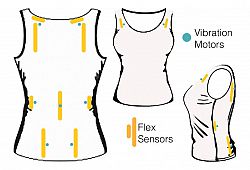 Award Winner: Katie Cooper
Award Winner: Katie CooperProduct: Posture Correction Vest
Personal experience of back pain and an interest in health and fitness inspired the direction of this final project. After some initial research, it was decided that the product designed should enable the user to improve their posture at a pace that suits them; in a more unobtrusive, portable and affordable manner than existing products allowed. A secondary interest in electronics guided the project towards the wearable technology area, providing the opportunity to explore e-textiles and different sewing techniques.
Poor posture contributes the estimated 9 million people suffering back pain daily, a large proportion of which are entirely preventable. Although there is an extensive range of products and treatments already available, the majority are not long term solutions and tend to be aimed towards the male market. The female posture correction vest, however, encourages you to make gradual, habitual changes in your posture in order to reduce your back pain.
Designed to to be worn discretely underneath your normal clothing, the posture correction vest individually monitors the location of key areas of your back using a series of flex sensors. Upon detecting an abnormal position, a small vibration is issued in the area concerned, allowing you to reposition yourself without the need for external technology. However, should you wish to track your days movements more accurately, the posture correction vest is also designed to work with both a desktop and mobile app.
To ensure you are able to wear the product every day, the physical garment is available separately from the sensors, meaning you can purchase several vests and easily transfer the sensors between them. An additional sportswear version helps you to maintain ideal posture during exercise, thus minimising the risk of injury.
- Tutors' Award: Design for Society
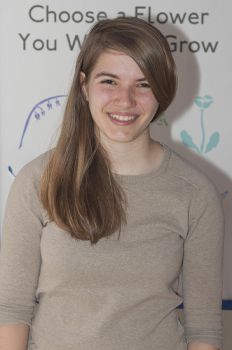
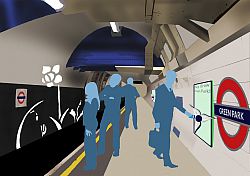 Award Winner: Anne Marie Marinho de Lemos
Award Winner: Anne Marie Marinho de LemosProduct: Grow Green Park
Stress is a rising problem in our urban lives because we fail to 'switch off' from our daily work. As we increase our office hours, we subsequently eat into our free time, thus having less time to relax and heighten the likelihood of illness which means we need to catch up on work by dedicating more time to it. This vicious circle is also the main reasons that prevent people from carrying out their hobbies and therefore, relieving stress. This project aims to reduce stress in London Underground commuters by adding a bit of play back into their lives.
The concept proposed is an interactive digital garden that 'grows' with each passing day as commuters interact with a panel on the wall of the platform which, in turn, grows the garden on the opposite wall across the platform. The aim is to focus it as a temporary installation for the months of January and February as they seem to be two months people most struggle with coping on the commute. The flowers chosen are seasonal to these wintery months. Features such as the digital flowers wafting in the wind as the tube pulls out of the station, create a beautiful and natural scenario to calm commuters in the dark, and at times, claustrophic tunnels by adding a bit of nature that they have digitally grown as a community.
Hopefully this will not only help tackle the high stress levels that commuters deal with by getting them back in touch with nature but also change the 'unspoken' underground etiquette' of avoiding communication with fellow commuters. There is a beauty in these cold months that are often overlooked, one just needs to take the time to find it and apprecaite it. With a little help from this product they should find it easier!
- Tutors' Award for Professional Design Services to the Product Design Degree Show

 Award Winner: Max Grew
Award Winner: Max GrewProduct: The Intrepid Large Format
The Intrepid Large Format camera is a redesign of the traditional large format camera; these cameras are the kind that uses bellows and sheets of film, with the photographer often placing a black cloth over his head to focus the image on a glass screen. The large format camera has its origins at the very beginning of photography; pictures were made onto glass plates covered in dangerous chemicals that required the sitter to stay still for minutes at a time. In the 1930s-50s they became the go to camera for press photographers and artists, with American photographer Ansell Adams becoming a pioneer in landscape photography.
Since then this branch of photography has continued defiantly to produce some of the most important and beautiful pictures ever created. It has resisted the digital revolution and continues to attract new passionate photographers despite the technology being over 100 years old. This attraction is for one simple reason, large format photography is as far away from digital photography you could possibly get, there is 0% automation, your camera does not have a microchip for a brain it has a photographer, it is entirely pure photography and allows maximum creative freedom. The large format camera is a tool for art, not convenience, the images have warmth to them akin to the sound of a vinyl record and a quality to them you just can’t quite put your finger on. So maybe it isn’t one simple reason, maybe I don’t really know exactly why these cameras are so special. I do however know they are manifestly important to the future of photography, and to me.
So why redesign this ‘perfect’ camera? Well there are two problems. Firstly this type of camera is very expensive often costing in the range of £800 to £1500, this becomes a limiting factor for new young photographers wishing to get started with this type of photography. Secondly these cameras tend to be mostly hand made, this is a real skill and one that could be lost if the cameras are not purchased by the next generation of photographers. It’s a downward spiral of high costs and loss of manufacturing knowledge that could eventually lead to these cameras no longer being produced. This is what led me to design an open source and affordable large format camera, The Intrepid.
- Tutors' Award for Most Innovative Product
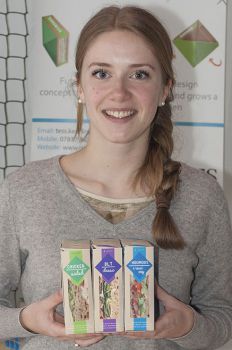
Two Winners were selected in this category.
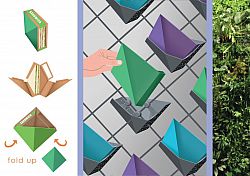
Award Winner: Tess Kenning (top photograph)
Product: Packaging for the Future
With the way we live, technology and society as a whole evolving rapidly it is important that we design for the future, especially within the packaging industry. This re-designed sandwich packaging is intuitive, more user friendly and has a prolonged use of life as it not designed to be disposed of normally but to be planted into a modular structure where it will sprout plants from the seeds within it as the paper decomposes. This product targets future trends in a society that is densely populated, leads a fast paced, on the go lifestyle and where sustainable living is not only a driving force but it is cool to care and be seen as being ‘green’. Therefore, instead of simply throwing your sandwich pack away, it allows the user to interact more with the packaging; fold it up and slot it into a vertical structure on a wall or fence around an office building. The paper itself has a pocket of seeds within it that grow out of the packaging as it degrades within the modular structure and will culminate in a plant and ultimately a vertical wall garden where the produce can be harvested in a cradle to cradle system. This unique product focuses on enhancing the relationship between the user and the product and aims to increase the awareness of the effect that FMCG (Fast Moving Consumer Goods) have on our environment.
By planting the package into the module on a wall instead of in a bin, the user can see their product grow over time and as multiple users join in it will create a community within the office environment it is aimed for. Not only will it show that the company itself is green but the vertical garden itself has benefits concerning employees’ wellbeing and helps to reduce energy usage of office buildings. Changing the way we view everyday products like packaging is vital to creating a sustainable world and this product does just that.

 Award Winner: Stewart Gordon (bottom photograph)
Award Winner: Stewart Gordon (bottom photograph)Product: Put a GRIN on Your Bin
GRIN is a product designed to increase the amount of glass that we recycle. It does this by solving two issues associated with glass recycling - the noise generated by collecting the glass and the lack of an incentive for people to recycle. Both of these have been identified as issues by Brighton & Hove City Council GRIN is a Glass Recycling Incentive, low Noise product that can be inserted into a range of existing communal recycling bins.
Primarily, GRIN eliminates much of the noise caused by glass bottles colliding on collection. This allows larger communal recycling bins to be located in residential areas which, in turn, leads to higher rates of recycling. This is achieved by decelerating the bottles fall through a layer of brushes.
Secondly, GRIN provides a mechanism to capture data on the amount of glass recycled by a single household, an individual bin or a community. This data allows councils to establish a reward scheme to encourage higher recycling rates. Data is captured by a clear object detection sensor, connected to an entry identification system. The whole system is solar powered.
Benefits of GRIN include:
- Higher rates of recycling
- Landfill reduction
- Council savings
- Community incentive
- Less noise
- Solar powered
- Tutors' Award for Most Professional Performance in the Final Year
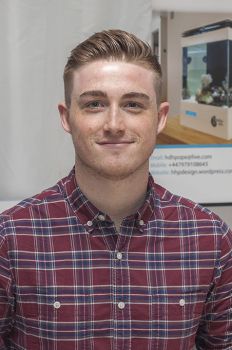
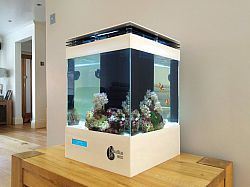 Award Winner: Harry Hummerstone-Pope
Award Winner: Harry Hummerstone-PopeProduct: Nautilus Eco - Automated Marine Habitat
Fish are the third most populous pet kept in the UK, however most people seem to be put off from keeping exotic marine species due to high running costs and the high levels of maintenance required, instead favouring freshwater species. The aim of my final year project was to to design a self contained eco system that could support all sorts of marine life that are native to coral reefs from all over the world. I believe that existing products on the market do not meet the needs of the everyday user and are overcomplicated and extremely expensive. Furthermore, existing methods of marine fish keeping require the use of disposable items such as filter cartridges that cannot be recycled, pushing me to discover more sustainable methods instead. Keeping saltwater fish should be a rewarding and relaxing hobby, so my aim was to design a solution to support this ideology.
From my own personal experience creating and maintaining a saltwater aquarium, I was able to develop the Nautilus Eco, a self contained aquarium with integrated biological filtration and automated systems designed to take the stress out of keeping demanding saltwater fish. Water within the aquarium is filtered naturally through Chaeto algae, purifying it and removing the need for constant maintenance. As well as filtration, the system includes low energy LED lighting to promote coral growth, and a notification screen that visually and audibly alerts users if there is an issue with the aquarium or when servicing is required. Handy features such as an automatic water level sensor even tops the aquarium back up when evaporation occurs, whilst the notification screen can provide step by step instructions to new users that require extra help and support.
The Nautilus Eco has a minimalist appearance, ensuring users are not distracted from the natural beauty of the life being supported within it, whilst the integrated technology allows users to relax and enjoy their hobby without worrying something will go wrong. The Nautilus Eco combines futuristic design and technologies usually priced out of budget for most users into one affordable system, providing a truly self contained ecologically-conscious option for users new to the hobby, or those that are tired of the high levels of maintenance that their current tanks require.
- Tutors' Award for Most Outstanding Product Design
-

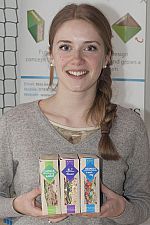 Award Winner: Tess Kenning
Award Winner: Tess Kenning Product: Packaging for the Future
With the way we live, technology and society as a whole evolving rapidly it is important that we design for the future, especially within the packaging industry. This re-designed sandwich packaging is intuitive, more user friendly and has a prolonged use of life as it not designed to be disposed of normally but to be planted into a modular structure where it will sprout plants from the seeds within it as the paper decomposes. This product targets future trends in a society that is densely populated, leads a fast paced, on the go lifestyle and where sustainable living is not only a driving force but it is cool to care and be seen as being ‘green’. Therefore, instead of simply throwing your sandwich pack away, it allows the user to interact more with the packaging; fold it up and slot it into a vertical structure on a wall or fence around an office building. The paper itself has a pocket of seeds within it that grow out of the packaging as it degrades within the modular structure and will culminate in a plant and ultimately a vertical wall garden where the produce can be harvested in a cradle to cradle system. This unique product focuses on enhancing the relationship between the user and the product and aims to increase the awareness of the effect that FMCG (Fast Moving Consumer Goods) have on our environment.
By planting the package into the module on a wall instead of in a bin, the user can see their product grow over time and as multiple users join in it will create a community within the office environment it is aimed for. Not only will it show that the company itself is green but the vertical garden itself has benefits concerning employees’ wellbeing and helps to reduce energy usage of office buildings. Changing the way we view everyday products like packaging is vital to creating a sustainable world and this product does just that.
































